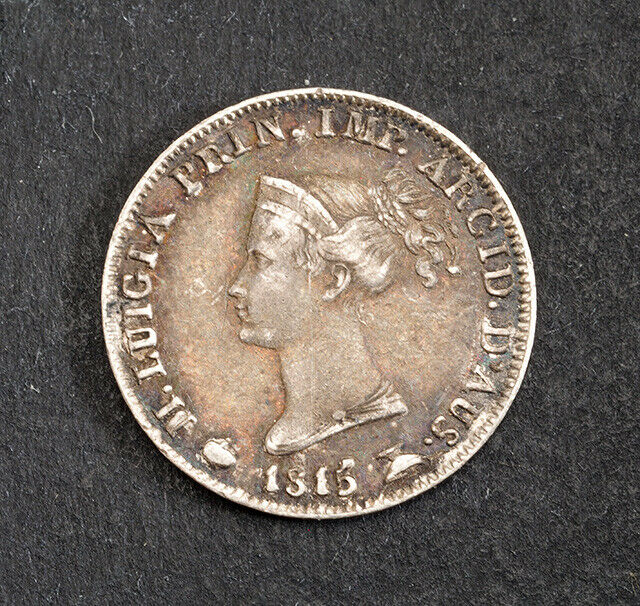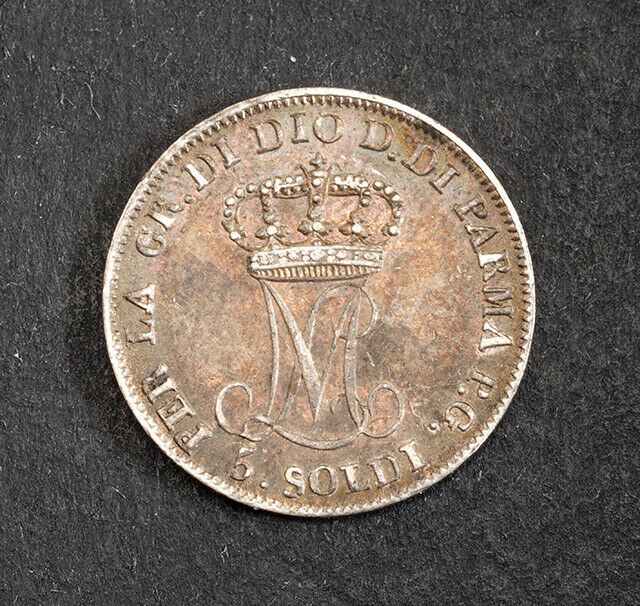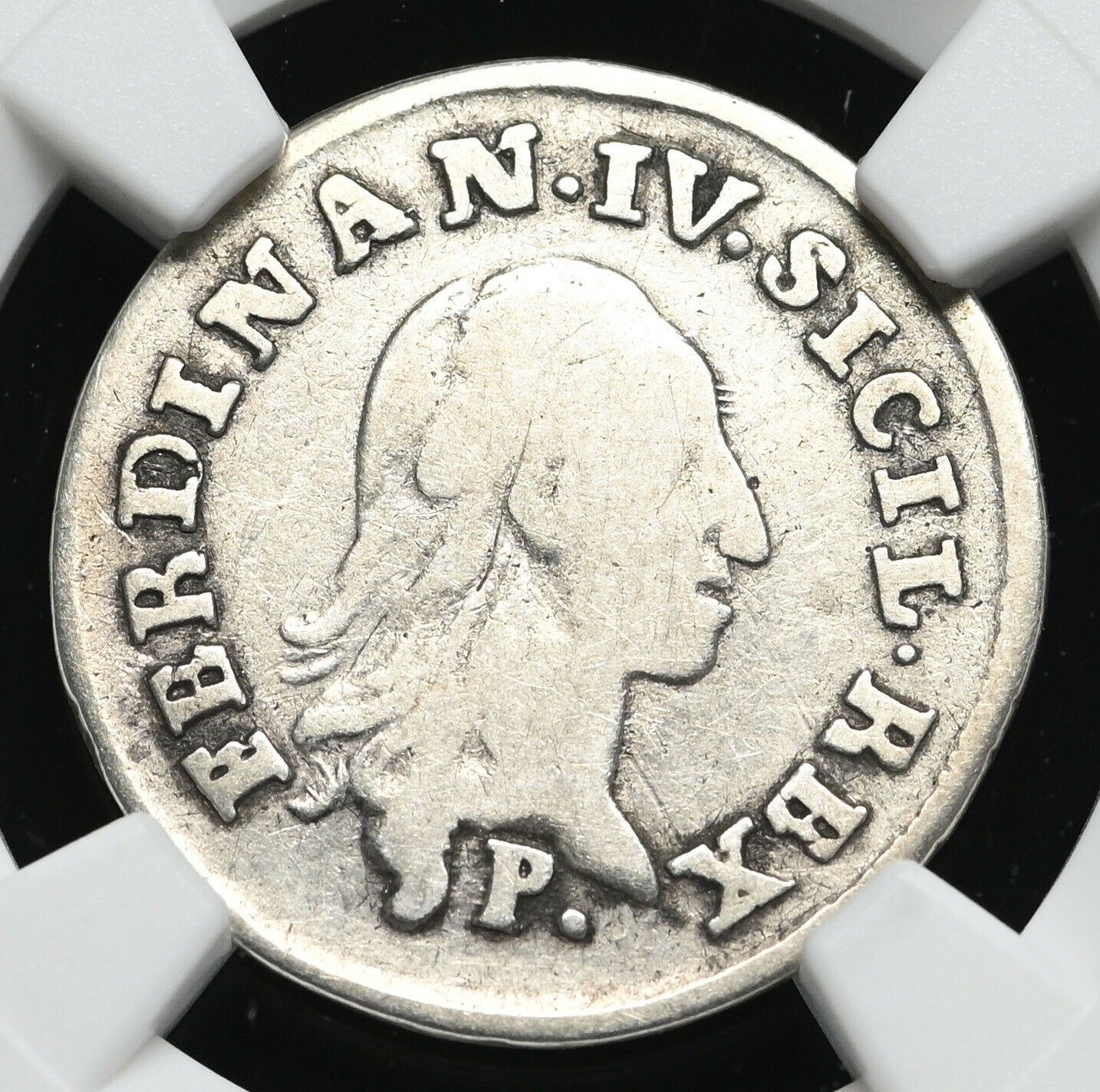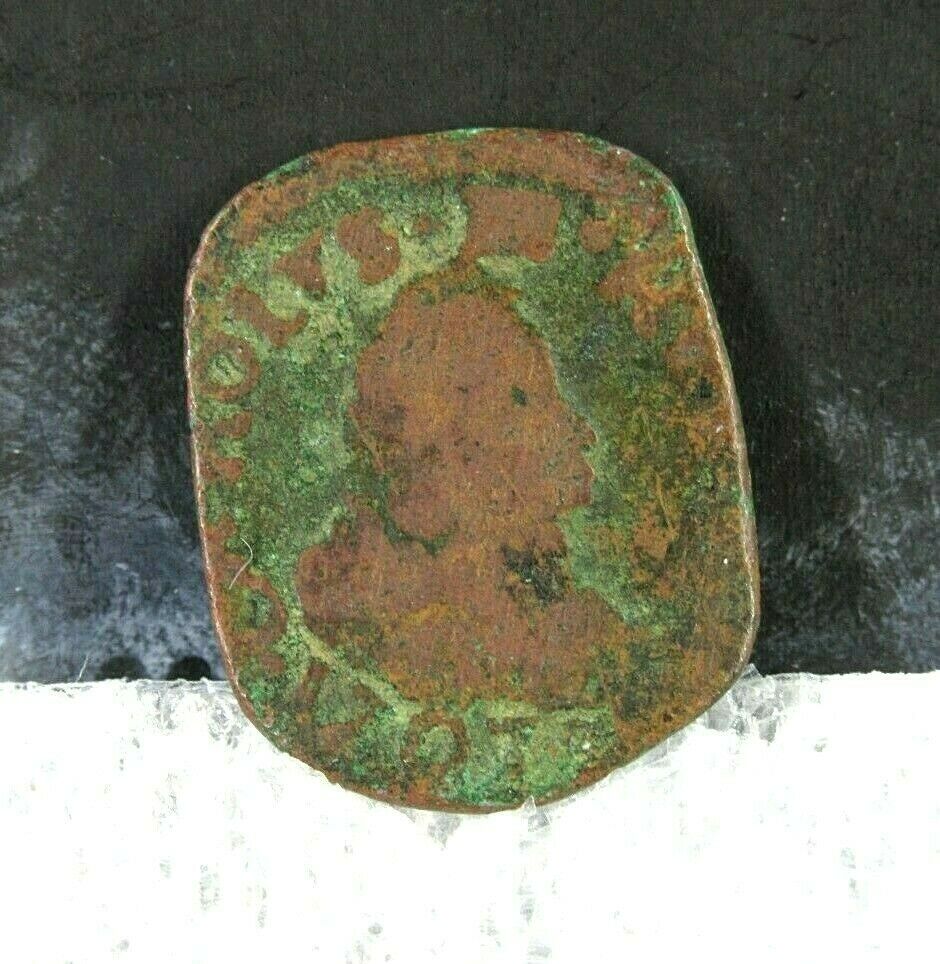-40%
1815, Parma (Duchy), Marie Louise of Austria. Beautiful Silver 5 Soldi Coin. XF-
$ 0.52
- Description
- Size Guide
Description
CoinWorldTV1815, Parma (Duchy), Marie Louise of Austria. Beautiful Silver 5 Soldi Coin. XF-
She was also French Empress and 2nd wife of Napoleon.
Mint Year: 1815
Reference: KM-26.
Denomination: 5 Solid
Mint Place: Milan (Italy)
Condition:
Scratches in obverse, otherwise a nicely toned XF!
Material: Silver (.900)
Diameter: 15mm
Weight: 1.24gm
Obverse:
Diademed bust of Marie Louise of Austria as Duchess of Parma, Piacenza and Guastalla left.
Legend: MARIA LUIGIA PRINC. IMP. ARCID. D' AUSTRIA (privy mark) 1815 (privy mark)
Reverse
: Crowned coat of arms of the duchy within collar of the Order of Saint George.
Legend: PER LA GR. DI DIO D. DI PARMA P. G . / 5. SOLDI
The Duchy of Parma was created in 1545 from that part of the Duchy of Milan south of the Po River, as a fief for Pope Paul III's illegitimate son, Pier Luigi Farnese, centered on the city of Parma.
In 1556, the second Duke, Ottavio Farnese, was given the city of Piacenza, becoming thus also Duke of Piacenza, and so the state was thereafter properly known as the Duchies of Parma and Piacenza.
In 1808 the duchies were annexed to France, by Napoleon Bonaparte. In 1814, the they were restored under his Habsburg wife, Marie Louise, who was to rule them for her lifetime. After Marie Louise's death in 1847, the Duchy was restored to the Bourbon-Parma line, which had been ruling the tiny Duchy of Lucca.
The duchies of Parma and Piacenza joined with the Grand Duchy of Tuscany and the Duchy of Modena to form the puppet United Provinces of Central Italy in December 1859, and were annexed to the Kingdom of Sardinia in March 1860.
The House of Bourbon continues to claim the title of duke of Parma to this day. Carlos-Hugo (Carlist pretender to the Spanish throne in the 1970s) has held the title since 1977.
Authenticity unconditionally guaranteed.
Bid with confidence!
Marie Louise of Austria
(German:
Marie Louise von Österreich
12 December 1791 – 17 December 1847), born
Archduchess Marie Louise of Austria
(German:
Erzherzogin Marie Louise von Österreich
), became upon marriage
Empress of the French
(French:
impératrice Marie Louise des Français
), and in 1817 became
Duchess of Parma, Piacenza and Guastalla
(Italian:
Maria Luisa, Duchessa di Parma, Piacenza e Guastalla
).
She was the second wife of Napoléon Bonaparte and thus Empress of the French. She was also a double grandniece of Marie Antoinette. She was the mother of Napoleon II, King of Rome.
Marie Louise (who was given the Latin baptismal name of
Maria Ludovica Leopoldina Francisca Theresa Josepha Lucia
) was born in Vienna, the daughter of Francis II, Holy Roman Emperor (Francis I of Austria) and of his second wife, Maria Theresa of the Two Sicilies. Marie Louise was also a double great-granddaughter of Maria Theresa of Austria, thus a double grandniece of Marie Antoinette, as she was a paternal granddaughter of Leopold II, Holy Roman Emperor (Maria Theresa's son, Marie Antoinette's brother) and a maternal granddaughter of Marie Caroline of Austria, Queen of Naples and Sicily (Maria Theresa's daughter, Marie Antoinette's sister).
To make her more marriageable, her parents had her tutored in many languages. In addition to her native German, she became fluent in English, French, Italian, Latin, and Spanish.
On 11 March 1810, the 18-year-old archduchess married French Emperor Napoléon I by proxy, with a subsequent ceremony taking place in the chapel of the Louvre on 1 April 1810. The bride's father intended the marriage to strengthen links between the Austrian Empire and the First French Empire. Napoleon sought the validation and legitimation of his Empire by marrying a member of the House of Habsburg, one of the oldest ruling families of Europe. He also hoped to cement his position by fathering a legitimate heir. Napoleon had previously tried to marry Grand Duchess Anna of the House of Romanov, younger sister of Tsar Alexander I of Russia, but his proposal had been refused.
When Marie Louise moved to France, she brought with her a number of Austrian recipes. She developed a recipe for roquefort-stuffed chopped beef that later became quite popular in restaurants.
On 20 March 1811, Marie Louise (as she was known in France) gave birth to a son, Napoléon François Joseph Charles Bonaparte, styled King of Rome and later Duke of Reichstadt. Marie Louise acted as Regent of France from April to December 1812 during the Russian campaign and again from April 1813 to January 1814 during her husband's absence in the German campaign. After Napoléon was forced to abdicate his throne in April 1814, he was exiled to the island of Elba. Marie Louise returned to Austria, never to see her husband again.
Napoléon claimed at one point to prefer Marie Louise to his first wife Joséphine de Beauharnais; while he had loved Joséphine, he claimed, he had not respected her, whereas with Marie Louise, there was "Never a lie, never a debt" — presumably a reference to Josephine's rumoured extramarital affairs and reputation as a spendthrift.
After Napoleon's abdication in April 1814, Marie Louise and her son fled Paris to Blois, and then to Vienna. The Treaty of Fontainebleau of 11 April 1814 allowed her to retain her imperial rank and style (Her Imperial Majesty The Empress Marie Louise) and made her the ruler of the duchies of Parma, Piacenza, and Guastalla, with her son as heir. However, in 1815, the Congress of Vienna revised this arrangement and made her Duchess of Parma for her life only, with the details of who would become Duke of Parma after her death unspecified. In 1817, a treaty was signed which would leave the duchies to a member of the House of Bourbon. In 1844 it was determined that the duchy of Guastalla would be inherited by the Duke of Modena.
In 1821, four months after Napoleon's death, Marie Louise married morganatically her lover, Count Adam Albert von Neipperg (1775-1829).
Only 1$ shipping for each additional coin purchased!











